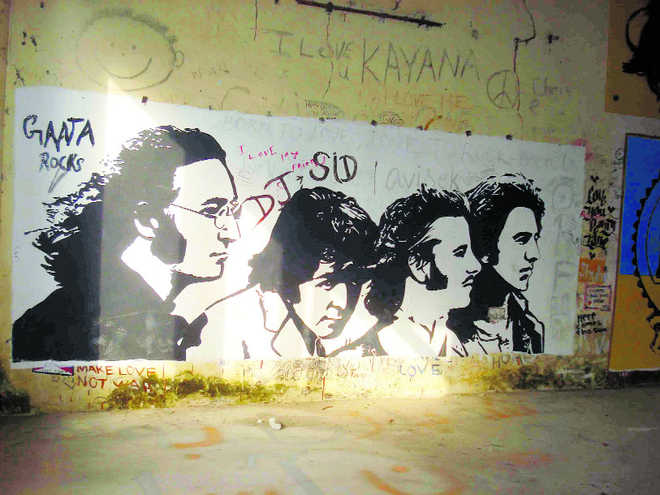“We are more popular than Jesus; I don't know which will go first – rock 'n' roll or Christianity!” — John Lennon
This uncharacteristic statement was made in March of 1966 by none other than John Lennon. Today, 49 years later, both the Beatles and Christianity persist – of course in ways that cannot be compared but can definitely be analogized. Proving, Tomorrow Never Knows, a misplaced premonition.
This statement – audacious yes; a complete lie, not really – was made by Lennon, the almost-messianic Beatle himself, quite routinely, during an an interview undertaken to cover, “How a Beatle lives”. It's been over 55 years since the formation of the band, and even today, its contribution to the controversial yet most promising decade in pop/rock music is glorified and celebrated.
So, when on December 10, 2015, the opening of the Beatles Ashram was announced by the Uttarakhand government, the ever-alive Beatlemania was further reinforced. The Beatles visited Maharishi Mahesh Yogi at his Ashram – Chaurasi Kutia in 1968 to practise transcendental meditation. The remote Ashram came to be known as the Beatles Ashram and was one of the biggest attractions for Western musicians, meditation enthusiasts and hipsters.
Pop & Moksha
The Beatles' visit not only made Rishikesh popular but propelled its popularity as a spiritual and religious center. Such was the widespread influence of the Liverpool Lads that it knew no geographical, cultural or religious boundaries.
The Beatles emerged on the scene in an already thriving yet volatile decade. The two world wars had recently ended and the Western world was witnessing a robust change in its economy, culture, race-dynamics and societal norms. People in Britain and North America were trying to fight off the new rigorous value system with their pre-modern ethics and worldview. Music too was an eclectic mix that resounded with impulse of freedom, subversive culture as it mirrored modern anxieties and complexes.
‘Good-boy’ phase
There are other factors too that made Beatles famous and their appeal everlasting. Especially, their beginner 'good-boy' phase that assured and relieved parents that there are other more ‘appropriated’ rock idols to fall back on, for their children. Secondly, their music and lyrics, at least initially, were without the otherwise prevalent melancholia or disillusionment, quiet commonly found in the rebel rock music of the 60s. If this wasn't enough, then there was Brian Epstein (also known as the fifth Beatle) who carefully managed and successfully executed marketing strategies for the Beatles to make them the biggest and the most popular stars there ever were. Gradually and progressively, The Beatles recorded the highest number of chart busters and ruled the Billboards.
The turmoil
They influenced an entire generation across continents, gender and even race. They wrote songs about innocent love, the blossoming of manhood, nuances of life and romantic idealism. However, post cultural turmoil of the 60s, student revolts and an unwavering influx of drug culture, they shifted their music to include songs about existential crisis that hits you in your mature years or the invisible populace that has no voice or face buried in the blinding city lights. They sang about philosophy, about spiritual investment, strawberry fields and spread the message of peace with oneself and in the world that we live while making all of us tolerant of psychedelia. It is said that their time at the Ashram was one of the most prolific phases of all in their career however, they soon became disillusioned with the entire meditation course and went back inspired but not encouraged (Sexy Sadie is a classic example) to continue on the path of transcendental meditation.
The break-up
Even after the bands fell out in 1970, the biggest proof of the Beatlemania was not in the number of concerts dedicated to them or in the number of movies made on them; not even in the throngs of people who attended concerts by individual Beatles or the number of women who felt unconscious at a mere sighting or in the fact that Richard Nixon wanted to deport Lennon. Neither it is in the iconic image of the Abbey Road crossing Beatles that sneaks up in every music cafe, 50 years hence, but in the height of obsession of a man, named Mark Chapman, who shot John Lennon on December 8, 1980 in New York. They say that Chapman was a huge Lennon fan and his obsession soon drove him to become a psychotic assassin. Such madness is not surprising when there were devotees of the Band, on the other end of the sanity spectrum, who would and could do anything in their power to make contact with these legendary musicians.
Ever-lasting impact
When the likes of the Rolling Stones, Bob Dylan, Pink Floyd, The Who and the Doors have a Beatlish streak and uber-popular grunge bands of the 90s, such as Pearl Jam and Nirvana, you know these serenading and inspiring footprints are not going to get washed away soon. As long as the history of Rock ‘n’ Roll is not forgotten and the Pop/rock Hall of Fame continues to cherish creativity, and the world gives its due to its soul-searchers, the Bealtes will have a place in our hearts and among our LP records or iTunes!
PS: The Beatles Ashram is now open and the tickets costs are Rs. 150 for locals and Rs 600 for foreigners. The Ashram now has murals painted on the walls by a graffiti artist from California, Pan Trinity Das. Having only scene images of the Ashram, I can gauge that the Ashram has tried to capture the Beatles' most creative phase in their musical history.
The writer works for an internet service provider firm
Unlock Exclusive Insights with The Tribune Premium
Take your experience further with Premium access.
Thought-provoking Opinions, Expert Analysis, In-depth Insights and other Member Only Benefits
Already a Member? Sign In Now










